April 16, 2009
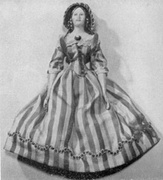
This article notes the toys popular among 18th-century children, especially focusing on dolls and describing the different variations that were available. It originally appeared in the March 1943 issue of American Collector magazine, a publication which ran from 1933-1948 and served antique collectors and dealers.
With children of early America, deference to parents and other elders and unquestioning obedience to those in authority were of prime importance. George Washington’s mother kept a bundle of peach branches in … (continue reading)
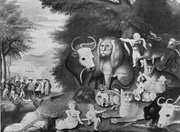
This article describes folk art paintings detailing the Peaceable Kingdom by three notable American primitive artists. It originally appeared in the August 1945 issue of American Collector magazine, a publication which ran from 1933-1948 and served antique collectors and dealers.
With interest focusing today on plans for world peace, it seems timely to juxtapose three remarkable versions of the Peaceable Kingdom, as interpreted by three generations of native American artists.
Edward Hicks is the first of these. He was … (continue reading)

This article focuses on the stamps created by the postmaster of the New York Post Office in the mid-19th century, noting how to determine how many stamps were originally on a sheet, how he signed stamps to prevent counterfeits, and how the stamp spread outside of New York. It originally appeared in the March 1943 issue of American Collector magazine, a publication which ran from 1933-1948 and served antique collectors and dealers.
The first American postmaster to … (continue reading)
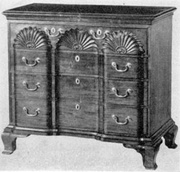
This article discusses the evolution of American chests of drawers, particularly their origins and the design styles, from Victorian to Greek Revival. It originally appeared in the April 1945 issue of American Collector magazine, a publication which ran from 1933-1948 and served antique collectors and dealers.
About a hundred and seventy-five years marks the span when the chest of drawers was being made by American cabinetmakers. During this time, step-by-step, the transition was accomplished from its predecessor … (continue reading)

This article on Bible boxes discusses their use as a writing surface and case for writing materials and describes their gradual evolution into a desk. It originally appeared in the November 1942 issue of American Collector magazine, a publication which ran from 1933-1948 and served antique collectors and dealers.
“I must write rudely,” stated Thomas Dudley of Massachusetts Bay colony in a letter to the Countess of Lincoln in the year 1631, “having no table, or other … (continue reading)

This article describes chairs made in England and America in the 18th century, noting their influences and how they compare to drawings in various craftsmen’s guides that were popular at the time. It originally appeared in the February 1947 issue of American Collector magazine, a publication which ran from 1933-1948 and served antique collectors and dealers.
It was the late R. T. Haynes Halsey who first noted that as early as 1775 there was a project in Philadelphia … (continue reading)

This article describes the evolution of cosmetic cases for women – especially perfume bottles – in use from 3000 B.C. until the 18th century, noting their designs and materials. It originally appeared in the December 1942 issue of American Collector magazine, a publication which ran from 1933-1948 and served antique collectors and dealers.
The world over, at all times women have tried to be more beautiful than nature created them. They made their personality harmonize with their appearance … (continue reading)
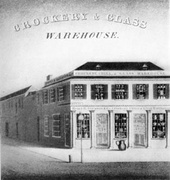
This article discusses the history of advertising, especially focusing on trade cards and broadsides. It notes the products that were advertised and the images used, and describes some of the well-known lithographers. It originally appeared in the June 1942 issue of American Collector magazine, a publication which ran from 1933-1948 and served antique collectors and dealers.
American advertising has always told a rousing story. What people had and what they could acquire. From the first issue … (continue reading)

This article discusses the historical significance of patriotic envelopes during the Civil War, describing the various pictures and slogans used and the messages represented from both sides. It originally appeared in the May 1943 issue of American Collector magazine, a publication which ran from 1933-1948 and served antique collectors and dealers.
The spontaneous upsurge of Blue and Gray patriotism generated by the Civil War is amazingly well caught and preserved in the colorful, heroic, flag-waving and caricaturing … (continue reading)
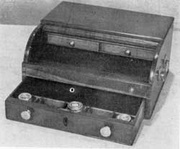
This article describes portable writing desks, from their materials to their design, and notes their history and their uses. It originally appeared in the May 1943 issue of American Collector magazine, a publication which ran from 1933-1948 and served antique collectors and dealers.
During the latter half of the 17th Century and the whole of the 18th, a period often referred to as the golden age of letter writing and diary … (continue reading)

This article discusses the history and traditions surrounding English standing cups and describes the style and design of the drinking vessels. It originally appeared in the February 1947 issue of American Collector magazine, a publication which ran from 1933-1948 and served antique collectors and dealers.
With whom you share a cup, with him share your friendship — that is in brief the tradition of the standing-cup.
Raising a glass to honor a distinguished guest at dinner; the “Here’s how!” … (continue reading)
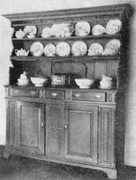
This article describes cupboards crafted in the 18th and 19th centuries that are appropriate for shelving and showcasing dishes, glass, and other collectibles. It originally appeared in the December 1945 issue of American Collector magazine, a publication which ran from 1933-1948 and served antique collectors and dealers.
Fine silver, porcelain, glass, and similar household accessories lend themselves to display as well as use, and the householder of today is no different than his ancestor of seven or eight … (continue reading)
April 3, 2009
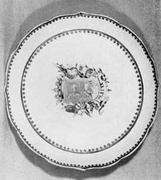
This article describes the export of goods from China to Mexico, noting Mexico’s origins as a stop on the trade route to Spain. It originally appeared in the February 1942 issue of American Collector magazine, a publication which ran from 1933-1948 and served antique collectors and dealers.
When one sees a piece of Oriental Lowestoft or a China trade item, the clock turns back a century and a half or more. In the shadow of such … (continue reading)

This article focuses on the history of American porcelain, noting the various materials used and some of the most recognized potteries. It originally appeared in the April 1947 issue of American Collector magazine, a publication which ran from 1933-1948 and served antique collectors and dealers.
Art pottery may be defined as intentionally decorative or ornamental ware but while the term “pottery” is usually limited to clay ware with a non-vitreous opaque body, “art pottery” must include vitreous porcelain … (continue reading)
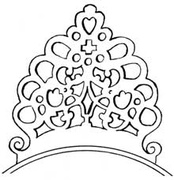
This article discusses the evolution of design of porringer handles made in New York during the 18th century, also addressing their Dutch influence and notable silversmiths who made porringers. It originally appeared in the April 1947 issue of American Collector magazine, a publication which ran from 1933-1948 and served antique collectors and dealers.
In the 19th century Americans gave little thought or attention to the work of our colonial craftsmen. If considered at all it was usually … (continue reading)















 How the American Flag Became Sacred—and the Hottest Brand in the Nation
How the American Flag Became Sacred—and the Hottest Brand in the Nation Let There Be Light Bulbs: How Incandescents Became the Icons of Innovation
Let There Be Light Bulbs: How Incandescents Became the Icons of Innovation Everything You Know About Corsets Is False
Everything You Know About Corsets Is False You've Got Mail Bombs: Tracking Down the Most Dangerous Letters in the World
You've Got Mail Bombs: Tracking Down the Most Dangerous Letters in the World Sacred Anatomy: Slicing Open Wax Women in the Name of Science and God
Sacred Anatomy: Slicing Open Wax Women in the Name of Science and God Mari Tepper: Laying it on the Line
Mari Tepper: Laying it on the Line Nice Ice: Valerie Hammond on the Genteel Charm of Vintage Canadian Costume Jewelry
Nice Ice: Valerie Hammond on the Genteel Charm of Vintage Canadian Costume Jewelry How Jim Heimann Got Crazy for California Architecture
How Jim Heimann Got Crazy for California Architecture Modernist Man: Jock Peters May Be the Most Influential Architect You've Never Heard Of
Modernist Man: Jock Peters May Be the Most Influential Architect You've Never Heard Of Meet Cute: Were Kokeshi Dolls the Models for Hello Kitty, Pokemon, and Be@rbrick?
Meet Cute: Were Kokeshi Dolls the Models for Hello Kitty, Pokemon, and Be@rbrick? When the King of Comedy Posters Set His Surreal Sights on the World of Rock 'n' Roll
When the King of Comedy Posters Set His Surreal Sights on the World of Rock 'n' Roll How One Artist Makes New Art From Old Coloring Books and Found Photos
How One Artist Makes New Art From Old Coloring Books and Found Photos Say Cheese! How Bad Photography Has Changed Our Definition of Good Pictures
Say Cheese! How Bad Photography Has Changed Our Definition of Good Pictures Middle Earthenware: One Family's Quest to Reclaim Its Place in British Pottery History
Middle Earthenware: One Family's Quest to Reclaim Its Place in British Pottery History Fancy Fowl: How an Evil Sea Captain and a Beloved Queen Made the World Crave KFC
Fancy Fowl: How an Evil Sea Captain and a Beloved Queen Made the World Crave KFC